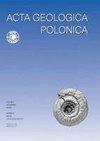Thin-and thick-skinned nappes of the southern slope of the Georgian Greater Caucasus: indicators of syn-collisional A-type subduction
IF 1.1
4区 地球科学
Q3 GEOLOGY
引用次数: 0
Abstract
In the region of the Caucasus considered herein two large structural complexes have been identified: an autochthone, including the Gagra-Java zone (GJZ) of the Greater Caucasus fold-and-thrust belt, the Kura foreland basin (KFB), and an allochthone consisting of the Utsera-Pavleuri, Alisisgori-Chinchvelta, Sadzeguri- Shakhvetila, Zhinvali-Pkhoveli nappes and Ksani-Arkala parautochthone. The nappes are established on the basis of paleogeographic reconstructions, structural data, as well as drilling and geophysical data. The leading mechanism for the nappe formation is the advancement to the north and the underthrusting of the autochthone under the Greater Caucasus (A-type subduction). The nappes were formed mainly in the Late Alpine time (Late Eocene–Early Pliocene) and include only the sedimentary cover of the Earth’s crust (thin-skinned nappes). However the basal detachment (décollement) of the nappes, according to seismic data, penetrates deeply and cuts the pre-Jurassic crystalline basement, and even the entire Earth’s crust representing thick-skinned deformation. The total horizontal displacement of the flysch nappes of the southern slope of the Greater Caucasus in their eastern (Kakhetian) part is 90–100 km. While, considering the folding of the entire Greater Caucasus, the total transverse shortening of the Earth‘s crust within its limits is equal to 190–200 km.格鲁吉亚大高加索山脉南坡的薄皮和厚皮岩层:同步碰撞A型俯冲的指标
在本文所考虑的高加索地区,已经确定了两个大型构造复合体:一个是自成地层,包括大高加索褶皱推覆带的加格拉-贾瓦区(GJZ)和库拉前陆盆地(KFB);另一个是全地层,包括乌采拉-帕夫勒乌里、阿里斯格里-钦奇维塔、萨代古里-沙赫韦蒂拉、钦瓦利-普霍韦利地层和克萨尼-阿卡拉副地层。这些岩层是根据古地理重建、构造数据以及钻探和地球物理数据确定的。岩层形成的主要机制是向北推进和大高加索下的自冲(A 型俯冲)。岩层主要形成于阿尔卑斯山晚期(始新世晚期-上新世早期),只包括地壳的沉积覆盖层(薄层岩层)。然而,根据地震数据,岩层的基底剥离(décollement)很深,切割了前侏罗纪的结晶基底,甚至整个地壳,代表了厚皮变形。大高加索山脉南坡东部(卡赫季)的褶皱岩层的总水平位移为 90-100 公里。而考虑到整个大高加索地区的褶皱,地壳在其范围内的总横向缩短相当于 190-200 公里。
本文章由计算机程序翻译,如有差异,请以英文原文为准。
求助全文
约1分钟内获得全文
求助全文
来源期刊

Acta Geologica Polonica
地学-地质学
CiteScore
1.70
自引率
18.20%
发文量
0
审稿时长
>12 weeks
期刊介绍:
Acta Geologica Polonica publishes original and review papers on all aspects of basic geology, with particular focus on sedimentology, stratigraphy, palaeontology, regional geology, structural geology, and regional petrography. All papers are published in English.
文献相关原料
| 公司名称 | 产品信息 | 采购帮参考价格 |
|---|
 求助内容:
求助内容: 应助结果提醒方式:
应助结果提醒方式:


